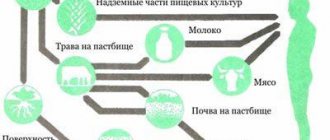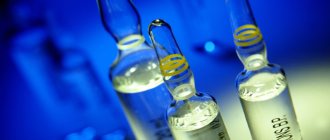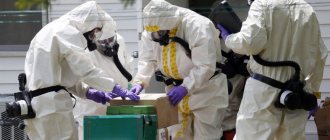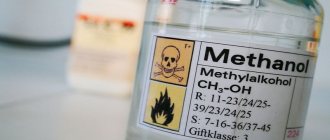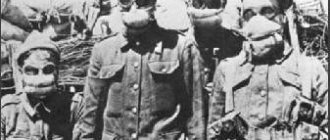Potently toxic substances (SPYAV)
- chemical compounds that are highly toxic and can, under certain conditions (mainly during accidents at chemically hazardous facilities), cause mass poisoning of people and animals, as well as contaminate the environment.
Currently, instead of the term SDYAV, the term Emergency Chemically Hazardous Substances (HAS)
.
Emergency chemically hazardous substance (HAS)
is a dangerous chemical substance used in industry and agriculture, in the event of an emergency release (spill) of which the environment can be contaminated in concentrations that can affect a living organism (toxodoses).
Main features of SDYAV:
- the ability to be carried over long distances in the direction of the wind, where it causes damage to people;
- volumetric action, that is, the ability of contaminated air to penetrate unsealed rooms;
- a wide variety of SDYAVs, which creates difficulties in creating filter gas masks;
- the ability of many SDYAVs to have not only a direct effect, but also to infect people through water, products, and surrounding objects.
Simultaneous contamination with two or more toxic agents can cause a combined effect of several poisons on the body. In this case, the toxic effect can be enhanced (synergism) or weakened (antagonism).
The most important characteristic of the danger of SDYAV is the relative density of their vapors (gases). If the vapor density of a substance is less than 1, this means that it is lighter than air and will dissipate quickly. A greater danger is posed by SDYAVs, the relative density of vapors of which is greater than 1, they remain at the surface of the earth longer (for example, chlorine), accumulate in various depressions in the area, and their impact on people will be longer.
According to the clinical picture of the lesion, the following types of SDYAV are distinguished:
- Substances with predominantly asphyxiating properties. with a pronounced cauterizing effect (chlorine, phosphorus trichloride);
- with a weak cauterizing effect (phosgene, chloropicrin, sulfur chloride).
- with a pronounced cauterizing effect (acrylonitrile);
- with alkylating activity (methyl bromide, ethylene oxide, methyl chloride, dimethyl sulfate);
Ways of influence of SDYAV on the human body:
- with food and water (oral);
- through the skin and mucous membranes (cutaneous-resorptive);
- by inhalation (inhalation).
In accordance with GOST 12.1.007-76 (99) “Harmful substances. Classification and general safety requirements”, according to the degree of impact on the human body, ADHS are divided into 4 hazard classes:
| Name | Standard for hazard class | |||
| indicator | 1st | 2nd | 3rd | 4th |
| Maximum permissible concentration (MPC) of harmful substances in the air of the working area, mg/cub.m | Less than 0.1 | 0,1-1,0 | 1,1-10,0 | More than 10.0 |
| Average lethal dose when administered into the stomach, mg/kg | Less than 15 | 15-150 | 151-5000 | More than 5000 |
| Average lethal dose when applied to the skin, mg/kg | Less than 100 | 100-500 | 501-2500 | More than 2500 |
| Average lethal concentration in air, mg/cub.m | Less than 500 | 500-5000 | 5001-50000 | More than 50000 |
| Inhalation Poisoning Possibility Quotient (POICO) | More than 300 | 300-30 | 29-3 | Less than 3 |
| Acute zone | Less than 6.0 | 6,0-18,0 | 18,1-54,0 | More than 54.0 |
| Chronic zone | More than 10.0 | 10,0-5,0 | 4,9-2,5 | Less than 2.5 |
- Class 1, extremely dangerous: phosphorus oxychloride, ethyleneimine, mercury.
- Class 2, highly hazardous: arsenic hydrogen, hydrocyanic acid, dimethylamine, fluorine, chlorine, etc.
- Class 3, moderately hazardous: trimethylamine, etc.
- Class 4, low-hazard: ammonia, methyl acrylate, acetone.
Substances of hazard classes 1 and 2 are capable of forming life-threatening concentrations even with minor leaks.
Currently, the Technical Regulations “On the Safety of Chemical Products” are being developed, which will have its own classification of chemical products that have acute toxicity.
SDYAV and their features
Potently toxic substances are a synthetic mixture that has increased toxicity and can lead to mass poisoning of people and contamination of the environment. There are a large number of such substances, so it becomes difficult to create gas masks that would filter the air. Contaminated air can penetrate into rooms that are not sealed and poison living organisms.
In addition, many ADHD affect people through water, food and various objects. They can be transported over vast distances in the direction of the wind. It is possible to become infected with several poisons as a result of environmental contamination with two or more toxins; the poisoning effect in this case may be enhanced or weakened. Particularly dangerous are SDYAV (we know the meaning of the abbreviation), the gas density of which is greater than unity. This means that such substances are heavier than air, so they can remain above the surface of the earth for a long period of time, accumulate in its recesses and affect living organisms for a very long time. If a substance has a gas density of less than one, then it will dissipate quickly, causing less harm.
Cases of dioxin pollution in world history
View gallery
Many countries monitor the amount of such a substance dangerous to human health as dioxin in food products. Instructions for the use of measures to control poisoning by this poison contribute to the early detection of contamination, often this helps prevent large-scale consequences. One such striking example is the discovery in 2004 of high concentrations of harmful compounds in dairy products in the Netherlands. After an investigation, the source of the contamination was identified. It turned out to be clay, which is widely used in the manufacture of animal feed. A similar case was registered in 2006, all in the same Netherlands. But then another source of infection was identified - fat, also included in the feed.
Dioxin is not just included in the list of toxic substances found in food products. He ranks first in it. In world history, there are also more large-scale cases of detection of this poison. For example, Ireland removed tons of pork from sale at the end of 2008. After samples were taken for testing, it turned out that the amount of dioxin in the meat exceeded the safe level by 200 times. This, of course, led to the country being forced to withdraw all pork products from sale. After conducting a study, experts found that hazardous products did not have time to reach customers’ tables, and the source of contamination was food. But meanwhile, this made us think about measures to prevent this from happening in the future.
Today, such a threat as dioxin cannot be ignored. The application of international standards to food products is a mandatory point in trade relations. For example, the European Commission issued a health warning to its countries in 2007 after a food additive known as guar gum, which was widely used as a thickening agent for meat products and desserts, was found to contain high levels of dioxin. It was established that the source of contamination was low-quality Indian resin.
Almost every year, there are reports from different countries about the detection of excessive concentrations of dioxin compounds in meat, dairy products, desserts, fish and even seafood delicacies. Most of these signals come from industrialized countries. This is explained by the fact that these countries have developed instructions for testing products for quality. Constant monitoring is also carried out.
Types of SDYAV
There are several types of toxic substances, which differ in the way they affect people:
- Asphyxiants can have a strong burning action, such as chlorine, or a weak action, such as sulfur chloride.
- Generally toxic substances that poison the entire body, for example, hydrocyanic acid.
- Generally poisonous and asphyxiating toxins may differ in their strong and weak cauterizing effects.
- Poisons that affect the nervous system, resulting in disruption of its functionality, for example, carbon disulfide.
- Potently toxic substances (SPYAV), which have both a suffocating and neurotropic effect, for example, ammonia.
- Metabolic toxins can have an alkylating effect and also alter the body's metabolism.
Depending on the method of exposure to a living organism, strong toxic substances are distinguished:
- Preoral – enters the body with food and water.
- Skin-resorptive method - penetration through mucous membranes and skin.
- Inhalation – the entry of toxins into the body through the air when it is inhaled.
List of substances
Initially, the list of substances classified as SDYAV was determined by the directive of the Chief of Staff of Civil Defense of the DNGO No. 7-88 and included 107 items.
Later, the list of substances was revised and shortened. Directive of the Chief of Civil Defense Staff of the DNGO No. 2 dated December 4, 1990 approved a list of 36 names of substances classified as SDYAV (later - hazardous substances). These include:
- Acrolein
- Acrylonitrile (acrylic acid nitrile)
- Ammonia
- Acetonitrile
- Acetone cyanohydrin (hydroxyisobutyric acid nitrile; hydroxyisobutyronitrile)
- Arsenic hydrogen (arsine)
- Hydrogen bromide (hydrogen bromide, hydrogen bromide)
- Hydrogen cyanide (hydrogen cyanide, hydrocyanic acid)
- Hydrogen fluoride (hydrogen fluoride, hydrogen fluoride, hydrofluoride)
- Hydrogen chloride
- Dimethylamine
- Sarin
- Soman
- Hydrochloric acid
- Methyl acrylate
- Methylamine
- Methyl mercaptan
- Methyl bromide
- Methyl chloride (methane chloride, methyl chloride)
- Nitrogen oxides
- Ethylene oxide
- Sulfur dioxide (sulfur dioxide)
- Hydrogen sulfide
- Carbon disulfide
- Trimethylamine
- Formaldehyde
- Phosgene
- Phosphorus trichloride (phosphorus trichloride, phosphorus(III) chloride)
- Phosphorus oxychloride (phosphoryl chloride)
- Fluorine
- Chlorine
- Chloropicrin
- Chlorcyanide
- Ethyleneamine
- Ethylene sulfide
- Ethyl mercaptan
Danger of poisonous toxins
Depending on the degree to which SDYAV (what it is - described above) affects a living organism, it is customary to distinguish four classes:
- Extremely dangerous, which are characterized by the presence of toxic substances in the air that cause death, less than 500 mg/cubic meter; upon contact with the stomach, death occurs in quantities up to 15 mg/kg; upon contact with skin, death occurs in quantities up to 100 mg/kg . This includes, for example, mercury, ethyleneimine and others.
- Very dangerous toxins, which are caused by a lethal amount in the air from 500 to 5000 mg/cub.m, in products that enter the stomach from 15 to 150 mg/kg, in contact with the skin in an amount from 100 to 500 mg/kg. This category includes, for example, chlorine and hydrocyanic acid.
- Moderately dangerous SDYAV (we know the decoding), which are characterized by mortality when present in the air from 5001 to 50,000 mg/cubic meter, when ingested in an amount from 151 to 5000 mg/kg and applied to the skin from 501 to 2500 mg /kg. This could be, for example, trimethylamine.
- Low-hazard toxins that cause death if the substance is present in the air more than 50,000 mg/cub.m, if it enters the stomach more than 5000 mg/kg and if it comes into contact with the skin more than 2500 mg/kg of the substance. These potent substances include acetone, ammonia, etc.
Even with the slightest leaks, toxins of the first and second classes can create concentrations that are especially dangerous to human life.
Literature
- GOST R 22.9.05-95. Safety in emergencies. Sets of personal protective equipment for rescuers. General technical requirements.
- GOST 12.1.005-88. SSBT. General sanitary and hygienic requirements for the air in the working area. (MPC for 1307 names of substances).
- GOST 12.1.007-76 (99) Harmful substances. Classification and general safety requirements.
- Temporary list of SDYAV. - M.: ShGO USSR, 1987.
- Directive of the NSH GO USSR No. 2 dated December 20, 1990. List of hazardous chemical products, the presence of which in production or storage in excess of established volumes requires the development of additional measures to protect the population in the event of an accident with these products.
- Federal Law of June 20, 1997 No. 116-FZ “On Industrial Safety of Hazardous Production Facilities”
Ammonia
This substance has a suffocating and neurotropic effect. Its smell is felt by humans when it is present in the air in an amount of 37 mg/cub.m. If a person smells an unpleasant odor of ammonia, it is necessary to immediately use special protective equipment. When inhaled with air, this substance causes pulmonary edema and damage to the entire human nervous system. There is lacrimation, pain in the eyes, burns on the skin, a suffocating cough, a delirious state and the person loses vision. Liquid ammonia causes chemical burns; when it evaporates, it leads to frostbite of varying degrees.
#2. Maitotoxin
There are many strong marine poisons, such as saxitoxin, that are often associated with toxic algae blooms. A person can become poisoned by these poisons, for example, after eating mussels.
Maitotoxin is one of the most powerful toxins known to mankind and has a very complex chemical structure
Mayototoxin is the deadliest of these substances. Its LD50 is thought to be a full notch lower than batrachotoxin. Produced by dinoflagellates (a type of marine plankton), the poison has a very complex chemical structure and is a cardiotoxin. It increases the flow of calcium ions across the membrane of the transverse muscle cells of the heart, causing heart failure.
Mercury
Children and the fairer sex are more prone to mercury poisoning. The form of poisoning depends on how much of the substance enters the body, as well as the duration of its influence: acute or chronic. Mercury vapor can be retained in the lungs; it also enters the body through intact skin. A person experiences pain when swallowing, bleeding gums, and vomiting. Then there are pain in the abdomen and chest, indigestion, pneumonia, shortness of breath, increased body temperature, and in severe cases, death occurs.
We already have an idea about SDYAV. What is chlorine? It is a yellow-green gas with a pungent odor that causes lung burns and suffocation. This is the very first toxic substance used by Germany in the First World War. To protect against chlorine, it is necessary to wear protective clothing, a gas mask, and gloves. You can also use a gauze bandage, which must first be moistened in a sodium sulfite solution.
Consequences of exposure to the body
Even after a long time after the cessation of exposure to chemical agents on the body, some symptoms of damage may persist. The result of exposure to generally toxic agents on the body can be:
- chronic renal failure;
- chronic disorders of the liver;
- paralysis or paresis of limbs;
- various neurological disorders (tremor, poor coordination of movements, problems with memory and speech).
It is very important to recognize poisoning as soon as possible and take the necessary protective and assistance measures, otherwise death is inevitable.
First aid
If affected by chlorine, put a gas mask on a person, take it to an uncontaminated area and perform artificial respiration. The mucous membranes are washed with water with the addition of soda. The patient is given a warm drink and provided with rest.
A person affected by ammonia is taken out into clean air, having first put a gas mask on him. Here he needs to be allowed to inhale water vapor, drink two glasses of warm water with one spoon of vinegar and induce vomiting. The mucous membranes are washed well with water. If ammonia caused chemical burns, they are treated with an anesthetic and bandaged.
In case of hydrogen sulfide poisoning, a person’s eyes are washed, they are instilled with Vaseline oil, previously boiled and cooled, and cold lotions are made. The throat must be rinsed with water with the addition of soda, and oxygen inhalations are performed. If pneumonia is observed, the patient is given antibiotics.
If affected by mercury, gastric lavage is done and activated carbon is administered. The patient must be constantly given something to drink to remove toxins from the body, periodically inducing vomiting. Sulfur is added to the water, which neutralizes mercury.
Sensitive subgroups
Determining dioxins in the environment is especially important for pregnant women. The most sensitive group to the effects of this poison are newborn children. Their rapidly developing nervous, endocrine and other organ systems are very vulnerable to the effects of dioxin-like compounds. Children under one year of age living near waste processing and disposal plants, as well as landfills, may experience developmental delays, complex pathologies, and cancer.
In addition, the risk group includes the population of some parts of the world where the main food product is fish and seafood. And, of course, workers at landfills, incinerators and the pulp and paper industry.
